Home Safety Checklist For St. Petersburg
Being safe in your residence should be your topmost priority. But are you missing one or two big safety items? Look over this home safety checklist for St. Petersburg and see where your home needs an update.
This guide starts with some whole-house safety techniques, and then we delve down to specific room ideas. Then, phone (727) 258-2938 or send in the form below to get your house ready.

Whole Home Safety Checklist for St. Petersburg
While you should employ a room-to-room approach to home safety, there are a few methods that are useful for the whole home. These components can talk to each other through a touchscreen hub, and often can respond to other things. You can also control each of your home safety equipment through a smartphone app, like ADT Control:
-
Monitored Security System: Each one of your doors and windows should employ a sensor that notifies you to a break-in. When your alarm goes off, your monitoring center answers the call and immediately contacts emergency personnel.
-
Smart Lighting For Each Room: Sure, you can program your smart lighting so your home is more energy-efficient. But they can also allow you to remain safe during an emergency. Have your downstairs lights flip on when an alarm goes off to frighten off intruders or light the way out to a safe place.
-
Smart Thermostat: Likewise, a smart thermostat in St. Petersburg should save you 10%-15% in gas and electric costs. Also, it can turn on an exhaust fan when your alarms senses a fire.
-
Monitored Smoke Detectors: It’s code that you have a fire detector on every level of your house. You can increase your fire game by utilizing a monitored fire detector that looks for both heat and smoke, and alerts your 24-hour monitoring agents when it senses a fire.
-
Smart Locks: Every doorway that uses a deadbolt can be made safer with a smart lock. Now you may program numbered codes to each family member and receive notifications to your phone when the locks are unlocked. Your locks can even automatically turn off, letting you quickly leave when you have an emergency.
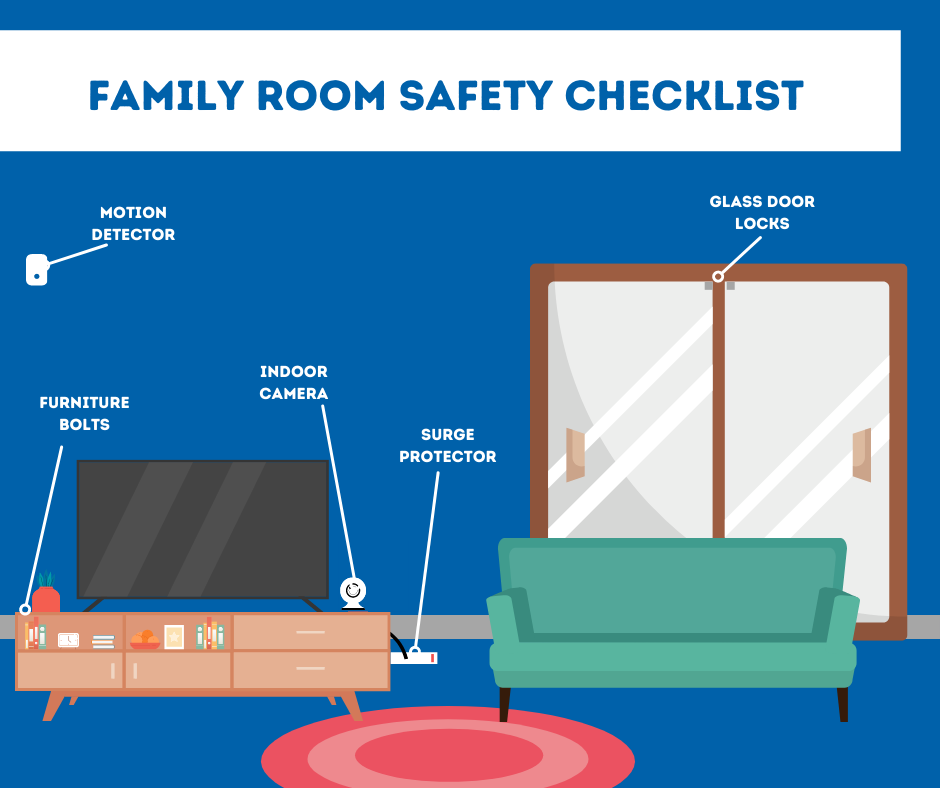
Living Room/Family Room Safety Checklist For St. Petersburg
You’ll spend a lot of time in your family room, so it’s the perfect place to improve your home safety. Popular items, like a TV or video game console, usually are located in your living room, making it an alluring room for burglars. Start with hanging a motion sensor or indoor security camera in there, then try the following suggestions:
-
Motion Detectors: By putting in motion detectors, you’ll hear a shrieking noise anytime they detect suspicious motion within your family room. The best devices are motion detectors that filter out a dog or cat or you’ll get an alert every time your cat roams by for a midnight stroll.
-
Security Camera: An indoor security camera gives you a constant watch on your family room. Get live streams of the area so you can know what’s downstairs through the mobile app. Or speak with your family in the room by using the two-way talk feature.
-
Surge Protector/Outlet Maintenance: Make sure you protect all your electronics and quit overloading your outlets with a surge protector. For additional convenience, use a smart plug with surge protection in the unit.
-
Heavy Furniture Secured To The Wall: If you have any small children, you’ll need to attach your heavy furniture and entertainment center to your wall. This is extra important if your family room has carpet that might make heavy objects extra unstable.
-
Enhanced Locks For Sliding Doors: If your family room has a sliding door that opens to a patio, deck, or outside porch, you already get that the latch is fairly worthless. Use a special lock, like a cross bar or locks that are located on the bottom and top of the frame.
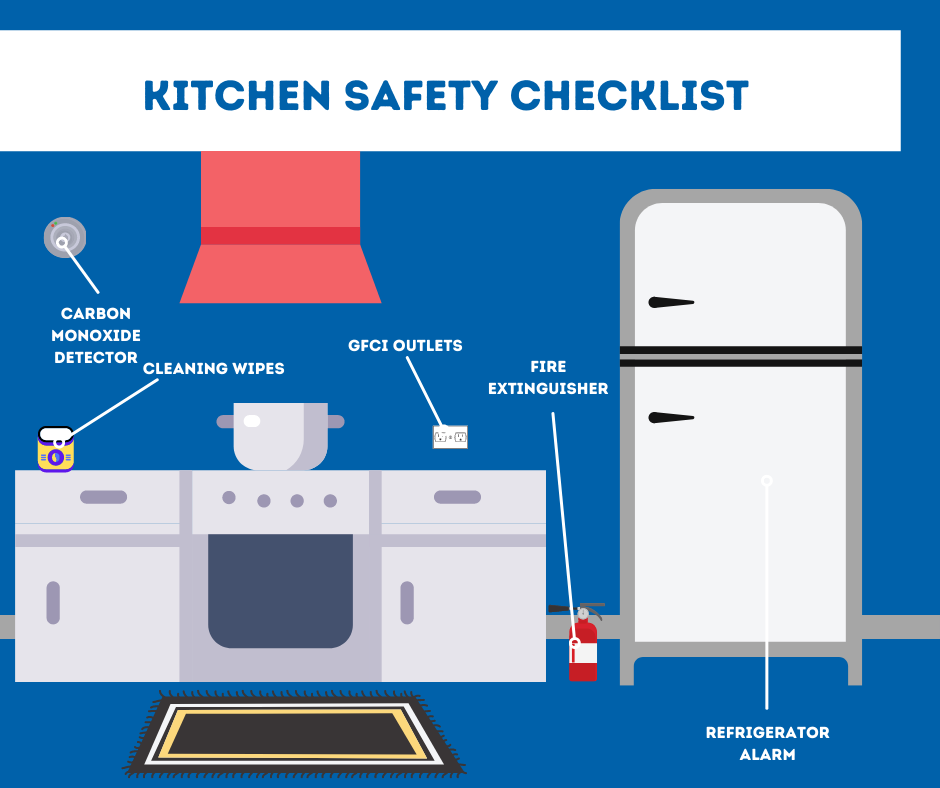
Kitchen Safety Checklist For St. Petersburg
The kitchen has plenty of items that can add safety and security to your home. Some of these objects are also a snap to add and should be found in the Target or Walmart:
-
Fire Extinguisher: Fire can happen from an unwatched skillet or an errant grease splatter. Always keep a fire extinguisher in close reach for any stove or oven mishaps.
-
GFCI Box On Every Outlet: A circuit interrupter outlet should be used on outlets where they’re by water to lessen the chance of a deadly shock. That includes the plugs around your kitchen counter and sink. For 30 years, it’s been standard to have one GFCI per circuit. But if you don’t want your whole kitchen to turn off when one outlet surges, you’re going to want to install an unchained GFCI per outlet.
-
Monitored CO Detector: A CO detector is handy in spaces that have gas for the oven and stove. If your gas appliances spring a leak, the carbon monoxide detector will play a loud siren and call your monitoring expert.
-
Cleaning Wipes Or Spray: The largest safety problem in the kitchen is actually bacteria and protein that comes with raw meat and vegetables. Always have cleaning wipes or an antibacterial spray to scrub off your surfaces before and after cooking.
-
Freezer and Refrigerator Alarm: The food items in your fridge need to remain at a constant temperature to be safe to eat. If you accidently leave the freezer or refrigerator door ajar, then a constant beep will let you know so you can close the door. Some fridges come with a pre-installed alarm, some do not, and you’ll have to buy a refrigerator alarm from the store.
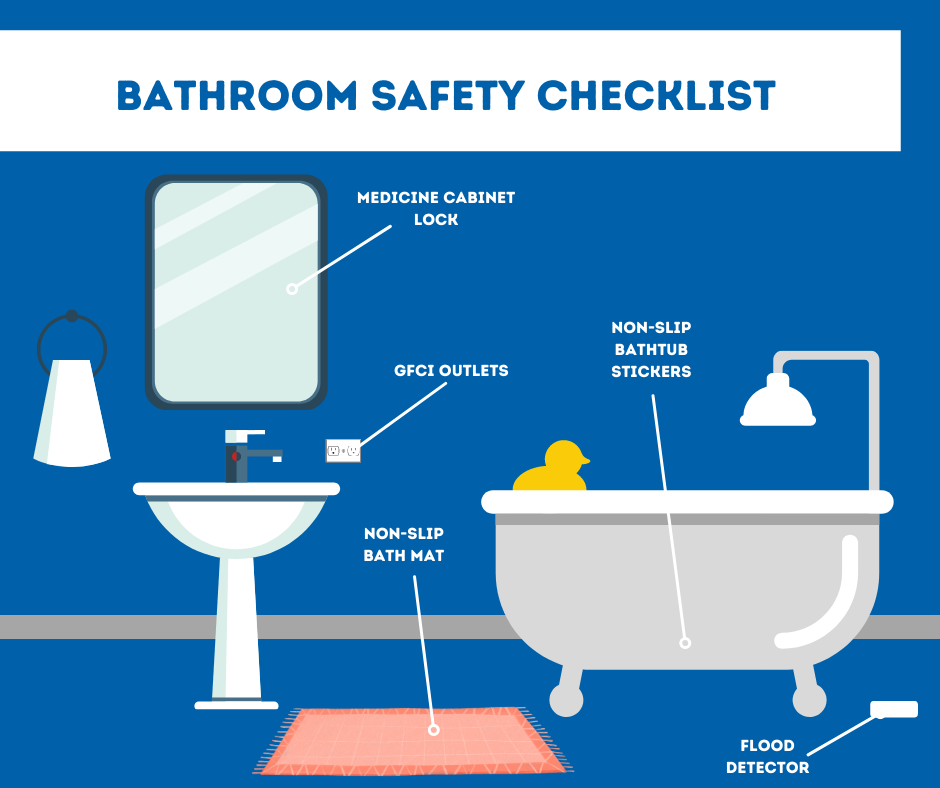
Bathroom Safety Checklist For St. Petersburg
Just because there’s not a bunch of space in your bathroom there’s still safety issues. From flood prevention to medicine care, here are some safety tips for your bathroom:
-
Flood Sensors: A leaking toilet or bathtub can cause an expensive amount of destruction. Discover a water problem with a flood detector and save hundreds to thousands of dollars from damage.
-
No-slip Shower Mats: A fall in the bathroom can be painful, causing bumps, gashed heads, or sprained ankles. You can avoid these problems with a textured bath mat for after your bath or shower.
-
Non-slip Bathtub Stickers: Like a tiled floor, a bathtub can be a slippery place to be on. Make sure each tub has some textured stickers so your toes have a textured patch for stability.
-
Medicine Door Latch: If you have curious kids or someone with memory complications, you need to take extra attention regarding prescribed medicine. Safeguard your bottles by getting a medicine cabinet with a child-proof lock.
-
GFCI Circuits: While installing better outlets in the kitchen, you should also put in a safer GFCI outlet on every bathroom receptacle. These will shut off the current if water splashes on them or there’s an unusual spike from a curling iron or hair dryer.

Children’s Bedroom Safety Checklist For St. Petersburg
Your child’s bedroom should balance safety with accessibility. If their window treatments or other items are safe but hard to use, then your kids may perform dangerous methods -- like shimmying up a chest of drawers -- to open them. Here are 5 simple, and safe, ideas:
-
Cordless Window Coverings: Safety experts have long called cords from shades and blinds a secret danger for kids and pets. Use motorized blinds or shades that you can easily open and close via remote control. Or go state-of-the-art and connect your motorized coverings to your security system so they can raise without anyone’s help when the sun comes up, and close at bedtime for extra privacy.
-
Tableside Security Camera: An indoor security camera placed on your kid’s desk can double as an HD baby monitor that you can watch with a smartphone. And when they need something, they can push the two-way talk feature on the camera.
-
Plug Covers: While every outlet should have protective covers on them when you have young children, this is doubly important in their bedroom. It’s the main place in your house where your child will most likely be by themselves without adult supervision.
-
Window Fire Ladder: If you have bedrooms on above the first story, then you need to put in a window fire ladder. These should let a child leave the house in case the hallway or downstairs are engulfed in smoke and fire. Just remember to go over how to use them at least twice a year.
-
Toy Chest Or Low Bookshelves: It’s weird to look at a toy box as a safety component, but you’ll understand if you’ve ever stepped on a building block in your socked feet. A clean floor means a quick escape when there’s a fire or break-in.
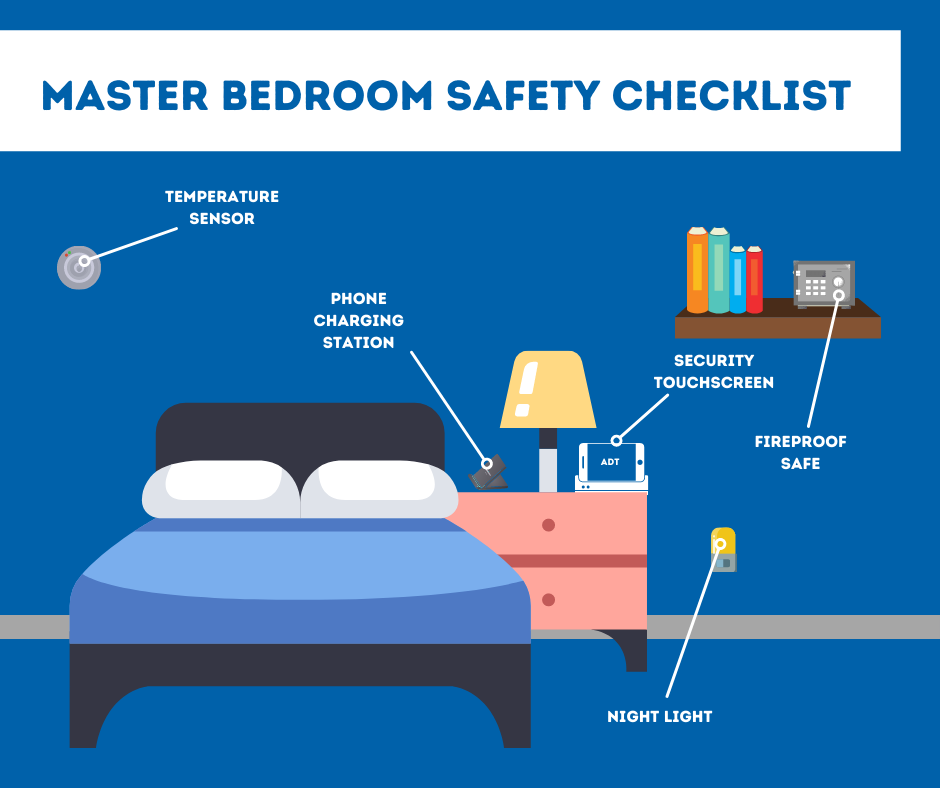
Master Bedroom Safety Checklist For St. Petersburg
The bedroom should be a refuge, so let your safety items make you more responsive if you experience an emergency event. After all, being wrenched awake by a loud alarm can be confusing.
-
Smart Hub Touchscreen: Having a touchscreen on your nightstand gives you a sense of what’s going on without getting out of bed. You could always turn on your ADT mobile app. However, the large touchscreen can be faster to use when you’re yawning and finding your bearings.
-
Phone Charging Area: We depend on our phones for almost everything now alarms, news readers, game machines, and --legend has it-- even phones. But, a dead cell will cut us off from the outside world if something goes wrong. To keep it nice and ready, a an easy-to-use charging station is an important part of your nightstand.
-
Smart Lights Or Nightlights: A tiny light helps ground you when you’re jolted awake from a fire alarm or other noises. If you won’t drift off to sleep with a nightlight, put in smart lights in your bedroom and hall. Then you can control light on-demand with a button push or voice command.
-
Fireproof Safe: Store your important documents like birth certificates, stock certificates, or a spare checkbook in a fireproof lockbox. Your safe can be a big one that camps out out of the way or a smaller handheld lockbox that you can grab when you leave during an emergency event.
-
Temperature Sensor: The problem with a master bedroom is that they can run too warm or be frigid because they are located far away from the thermostat. A temperature sensor can communicate to your smart thermostat so you can have a nice, restful sleep at a wonderful climate.
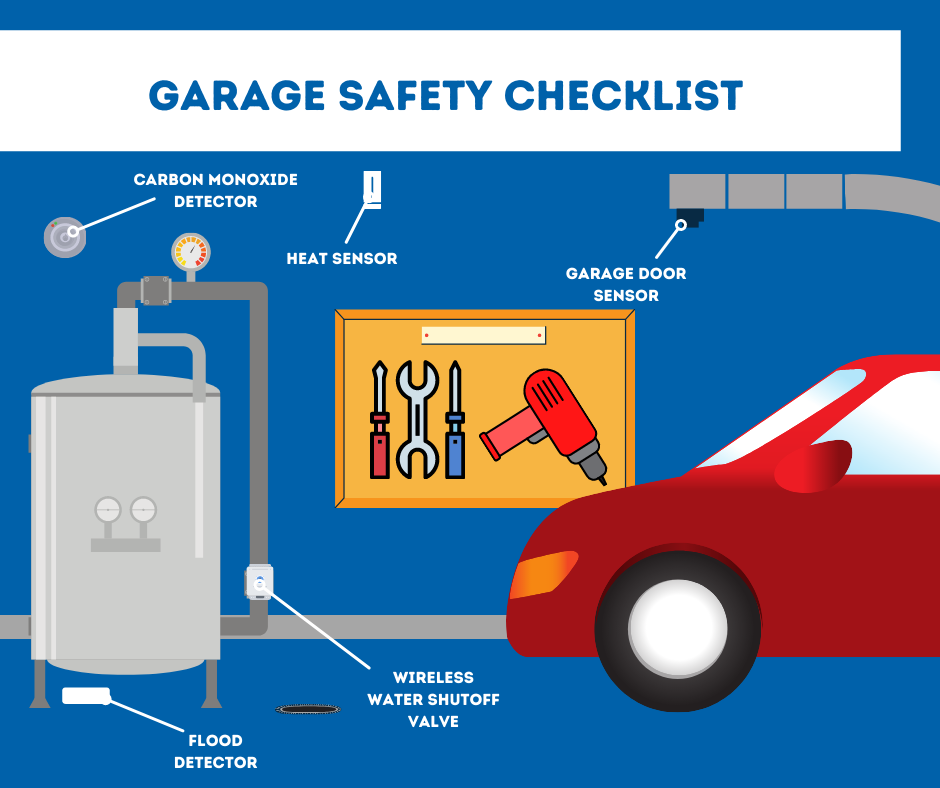
Basement/Garage Safety Checklist For St. Petersburg
Most safety issues in the garage or basement deal with your pipes or heating system. Finding issues at the source can prevent bigger disasters in the future. So, as you walk around your basement or garage, take note of these safety items:
-
Water Sensor Or Sump Pump Alarm: Placing a flood sensor next to your water heater or sump pump can stop you from discovering a mess when you step into your basement or garage. The last you need is to spend the weekend bailing out water and sorting through all those soggy boxes.
-
CO Detector: It’s beneficial to install a carbon monoxide alarm in an area where a gas leak can spring up. If you employ gas heating, you should put a detector in the same area as your HVAC unit.
-
Remote Water Shutoff Valve: If your water detector senses a plumbing leak or a broken pipe, then you will want to cut off the main water valve at once. With a wireless shutoff valve, you can turn off your water flow from anywhere in the world. That’s helpful when you’re visiting relatives and receive a water leak notification on your mobile device.
-
Garage Door Sensor: Leaving the garage up causes all sorts of headaches. You can lose a bunch of heat or air through that open door, and rodents or thieves can just saunder in. A sensor will text you about a neglected garage door and lets you close it with your phone.
-
Heat Sensor: A heat sensor in your basement or garage is essential if you fret about freezing pipes. The heat in these rooms can be wildly different than your main rooms of the house, so you may need to maintain a constant look on the temp by using the ADT mobile app.
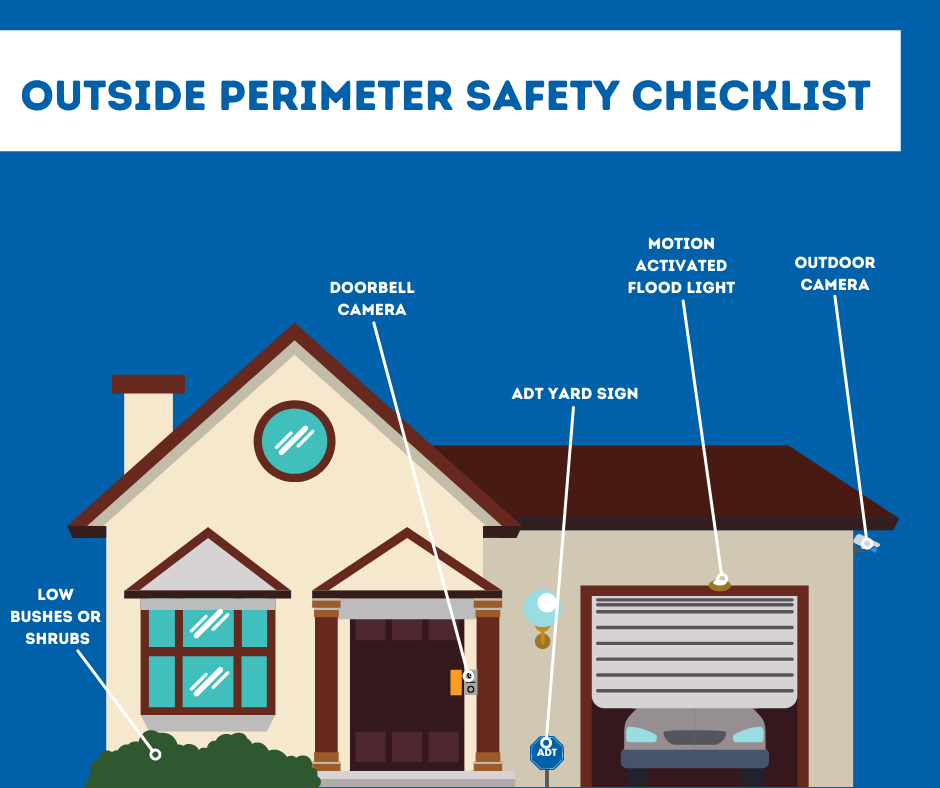
Outside Perimeter Safety Checklist for St. Petersburg
Your front yard, drive, and front step are just as crucial to make safe as the interior of your home. Try this checklist to defend your perimeter:
-
Doorbell Security Camera: See who’s at the door before you open it and talk to guests. Get a visual on packages and review video clips if they vanish off the step.
-
Outdoor Security Camera: You can install outdoor security cameras to guard against late night activity in your back yard. These security cameras come in handy in areas where you might not have a window installed -- like a side yard or by the garage door.
-
Low Shrubbery: High bushes can create some privacy, but they also block your view of the yard. Don’t provide potential thieves an area to hide. Plus, tall shrubs or greenery against your structure can jam up gutters and summon bugs.
-
ADT Yard Signs: One of the most popular deterrents for a break-in is advertising to potential intruders that you own an updated home security system. An ADT yard stick by the stoop and a window cling will tell ne'er-do-wells that they should move on to an less prepared target.
-
Motion Triggered Flood Lighting: Light is the largest enemy to those who sneak around in the shadows. Motion-triggered lights on your deck, patio, or garage can shoo lurkers away. They also help you see the walk when you get to the house on those dark, winter nights.
Call Secure24 Alarm Systems To Help Complete Your Home Safety Checklist for St. Petersburg
While Secure24 Alarm Systems can’t install non-security devices on your St. Petersburg home safety checklist, we can install a powerful home security. With easy-to-use devices and ADT monitoring, we can install the ideal system for your family’s needs. Just contact (727) 258-2938 for more information or complete the form below. Or customize your own system with our Security System Designer.
